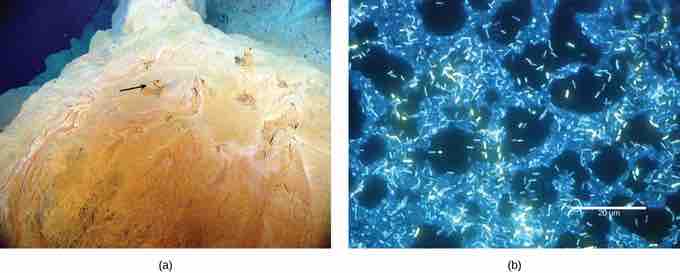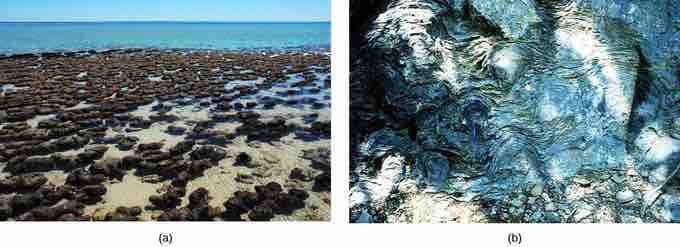Prokaryotes, the First Inhabitants of Earth
When and where did life begin? What were the conditions on earth when life began? Prokaryotes were the first forms of life on earth, existing for billions of years before plants and animals appeared. The earth and its moon are thought to be about 4.54 billion years old. This estimate is based on evidence from radiometric dating of meteorite material together with other substrate material from earth and the moon. Early earth had a very different atmosphere (contained less molecular oxygen) than it does today and was subjected to strong radiation; thus, the first organisms would have flourished where they were more protected, such as in ocean depths or beneath the surface of the earth. Also at this time, strong volcanic activity was common on Earth. It is probable that these first organisms, the first prokaryotes, were adapted to very high temperatures. Early earth was prone to geological upheaval and volcanic eruption, and was subject to bombardment by mutagenic radiation from the sun. The first organisms were prokaryotes that could withstand these harsh conditions.
Although probable prokaryotic cell fossils date to almost 3.5 billion years ago, most prokaryotes do not have distinctive morphologies; fossil shapes cannot be used to identify them as Archaea. Instead, chemical fossils of unique lipids are more informative because such compounds do not occur in other organisms. Some publications suggest that archaean or eukaryotic lipid remains are present in shales dating from 2.7 billion years ago. Such lipids have also been detected in Precambrian formations. The oldest such traces come from the Isua district of west Greenland, which include earth's oldest sediments, formed 3.8 billion years ago. The archaeal lineage may be the most ancient that exists on earth.
Within prokaryotes, archaeal cell structure is most similar to that of gram-positive bacteria, largely because both have a single lipid bilayer and usually contain a thick sacculus of varying chemical composition. In phylogenetic trees based upon different gene/protein sequences of prokaryotic homologs, the archaeal homologs are more closely related to those of Gram-positive bacteria. Archaea and gram-positive bacteria also share conserved indels in a number of important proteins, such as Hsp70 and glutamine synthetase.
It has been proposed that the archaea evolved from gram-positive bacteria in response to antibiotic selection pressure. This is suggested by the observation that archaea are resistant to a wide variety of antibiotics that are primarily produced by gram-positive bacteria and that these antibiotics primarily act on the genes that distinguish archaea from bacteria. The evolution of Archaea in response to antibiotic selection, or any other competitive selective pressure, could also explain their adaptation to extreme environments (such as high temperature or acidity) as the result of a search for unoccupied niches to escape from antibiotic-producing organisms.
Microbial Mats
Microbial mats or large biofilms may represent the earliest forms of life on earth; there is fossil evidence of their presence starting about 3.5 billion years ago. A microbial mat is a multi-layered sheet of prokaryotes that includes mostly bacteria, but also archaea . Microbial mats are a few centimeters thick, typically growing where different types of materials interface, mostly on moist surfaces. The various types of prokaryotes that comprise the mats use different metabolic pathways, which is the reason for their various colors. Prokaryotes in a microbial mat are held together by a glue-like sticky substance that they secrete called extracellular matrix.

Microbial mat
This (a) microbial mat, about one meter in diameter, grows over a hydrothermal vent in the Pacific Ocean in a region known as the "Pacific Ring of Fire." The mat helps retain microbial nutrients. Chimneys, such as the one indicated by the arrow, allow gases to escape. (b) In this micrograph, bacteria are visualized using fluorescence microscopy.
The first microbial mats likely obtained their energy from chemicals found near hydrothermal vents. A hydrothermal vent is a breakage or fissure in the earth's surface that releases geothermally-heated water. With the evolution of photosynthesis about 3 billion years ago, some prokaryotes in microbial mats came to use a more widely-available energy source, sunlight, whereas others were still dependent on chemicals from hydrothermal vents for energy and food.
Stromatolites
Fossilized microbial mats represent the earliest record of life on earth. A stromatolite is a sedimentary structure formed when minerals are precipitated out of water by prokaryotes in a microbial mat . Stromatolites form layered rocks made of carbonate or silicate. Although most stromatolites are artifacts from the past, there are places on earth where stromatolites are still forming. For example, growing stromatolites have been found in the Anza-Borrego Desert State Park in San Diego County, California.

Stromatolites
(a) These living stromatolites are located in Shark Bay, Australia. (b) These fossilized stromatolites, found in Glacier National Park, Montana, are nearly 1.5 billion years old.